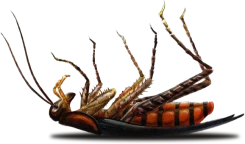Loud and Lively: Cicadas
Those of us living in the northeastern coast have surely heard about the 17-year cicadas that will amass into the trillions this summer. But what are cicadas and what should you know about them?
Cicadas are a type of insect classified as a true bug. They come in different sizes and colors with each having their own specific mating call, but share similar needle-like mouthparts. There are two main types of cicadas: periodical and annual. Periodical cicadas are present during certain periods of time, generally every 13 years or 17 years, depending on brood and species, and are smaller than annual cicadas. Annual cicadas are present each year and are larger than periodical cicadas.
The cicada’s life begins as eggs are laid by the females in the bark of tree branches. These eggs then hatch into nymphs after 4-6 weeks and they fall to the ground where they burrow down to find tree roots, their primary source of food. The nymphs will feed on the fluid in the roots with their needle-like mouthparts. They remain underground for the entire nymph stage, molting and growing larger, until they are ready for their final molt into adulthood. The nymph will push through the soil up to the top and find a surface, such as a tree or fence post, to rest while they molt their final nymphal exoskeleton.
Male cicadas have a loud mating call, which varies between species and can reach 88 decibels – similar in volume to a subway or motorcycle! The females will fly to the males and breed, continuing the life cycle. While the adults may feed on tree sap, they typically do not live more than 4-6 weeks after emergence and mating.
Cicadas rarely harm trees with their feeding behavior, but a branch can be killed if enough females choose to lay eggs in the same branch. The only way to keep cicadas from attacking sapling branches during outbreaks is to cover it in netting that has ¼” holes. This will prevent cicadas from laying eggs in the branches.


Why Choose Us?
Providing Reliable Pest & Wildlife Solutions Since 1939
At Home Paramount Pest Control, we have been dedicated to delivering reliable pest and wildlife management solutions for over 80 years. Our long-standing presence in the industry speaks volumes about our commitment to excellence and customer satisfaction. When you trust our team, you can always count on:
- Customized solutions to suit your specific needs
- Same-day service availability for pest infestation emergencies
- High-quality green products that are safe for the environment
- Complimentary pest inspections
- Affordable financing solutions tailored to your budget
Call us at 888-888-4663 to get started with a free pest inspection for your property today!
Learn More

